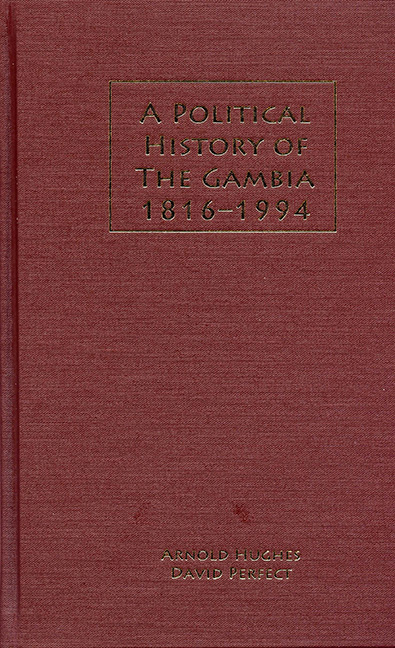Book contents
- Frontmatter
- Dedication
- Map
- Contents
- List of Tables
- List of Interviewees
- Acknowledgments
- Abbreviations
- Introduction
- 1 Social and Economic Setting
- 2 Constitutional Change in The Gambia, 1816–1994
- 3 Merchants and Recaptives: The Origins of Modern Politics, 1816–86
- 4 Patrician Politics in the Era of the Forsters, 1886–1941
- 5 The Establishment of Party Politics, 1941–59
- 6 The “Green Uprising”: The Emergence of the People's Progressive Party, 1959–65
- 7 Electoral Politics, 1965–81
- 8 Radical and Insurrectionary Political Challenges, 1965–81
- 9 Electoral Politics, 1981–94
- 10 The Gambia's External Relations, 1965–94
- 11 The 1994 Coup and the Jawara Legacy
- Appendix A Major Constitutional Changes, 1816–1994
- Appendix B Legislative Council Election Results, 1947–54
- Appendix C General Election and By-Election Results, 1960–93
- Appendix D Presidential Election Results, 1982–92
- Appendix E Republic Referendum Results, 1970
- Appendix F Primary Sources
- Appendix G Newspapers and Magazines Consulted
- Notes
- Bibliography
- Index
- Rochester Studies in African History and the Diasora
11 - The 1994 Coup and the Jawara Legacy
Published online by Cambridge University Press: 13 April 2017
- Frontmatter
- Dedication
- Map
- Contents
- List of Tables
- List of Interviewees
- Acknowledgments
- Abbreviations
- Introduction
- 1 Social and Economic Setting
- 2 Constitutional Change in The Gambia, 1816–1994
- 3 Merchants and Recaptives: The Origins of Modern Politics, 1816–86
- 4 Patrician Politics in the Era of the Forsters, 1886–1941
- 5 The Establishment of Party Politics, 1941–59
- 6 The “Green Uprising”: The Emergence of the People's Progressive Party, 1959–65
- 7 Electoral Politics, 1965–81
- 8 Radical and Insurrectionary Political Challenges, 1965–81
- 9 Electoral Politics, 1981–94
- 10 The Gambia's External Relations, 1965–94
- 11 The 1994 Coup and the Jawara Legacy
- Appendix A Major Constitutional Changes, 1816–1994
- Appendix B Legislative Council Election Results, 1947–54
- Appendix C General Election and By-Election Results, 1960–93
- Appendix D Presidential Election Results, 1982–92
- Appendix E Republic Referendum Results, 1970
- Appendix F Primary Sources
- Appendix G Newspapers and Magazines Consulted
- Notes
- Bibliography
- Index
- Rochester Studies in African History and the Diasora
Summary
On Friday July 22, 1994, President Jawara and the People's Progressive Party (PPP) government were overthrown in a bloodless coup by a group of young junior officers of the Gambian National Army (GNA) who subsequently established the Armed Forces Provisional Ruling Council (AFPRC) government. The first part of this chapter analyses this coup in detail. As pointed out both by Wiseman and Vidler and by Saine, it marked the demise of the longest continuously surviving multiparty democracy in Africa and ended the period in office of the longest serving national leader in Africa; it also meant that The Gambia was traveling in the opposite direction to many sub-Saharan states, which were moving toward some kind of multiparty political system. The ending of the Jawara era was a particularly significant moment in Gambian history and the second part of the chapter assesses his overall contribution to Gambian public life.
1994 Coup
The coup has previously been examined by a number of authors writing from a range of perspectives. These published sources have more recently been supplemented by a series of Internet articles written by a GNA officer of the time, believed to be Captain Sheriff Samsudeen Sarr (using the pseudonym “Ebou Colly”). As outlined below, there are some differences between the sources. However, two common themes have been the internal grievances of the military and the problems of civil society at the time of the coup. These are considered first, before the course of events during the coup and its immediate aftermath are described. In this chapter, a number of comparisons are made with the failed coup of 1981 and also with other successful military coups in Africa.
Chapter 8 pointed out that, following the suppression of the 1981 coup, the discredited Field Force was disbanded in 1982. It was initially replaced by a Senegalese-trained confederal army, staffed mainly by Senegalese soldiers. Subsequently, two separate forces were established: the GNA, which was created in 1983–84 under the command of a Gambian, Colonel Momodou N'Dow N'Jie, and the Gambian National Gendarmerie (GNG), which was gradually built up from 1982. In 1992, the GNG was integrated into the Tactical Support Group (TSG), composed of former members of the GNG and former civilian police officers. The GNA received British military assistance (until 1991), and the GNG was trained by Senegalese officers.
- Type
- Chapter
- Information
- A Political History of the Gambia, 1816–1994 , pp. 280 - 294Publisher: Boydell & BrewerPrint publication year: 2006

